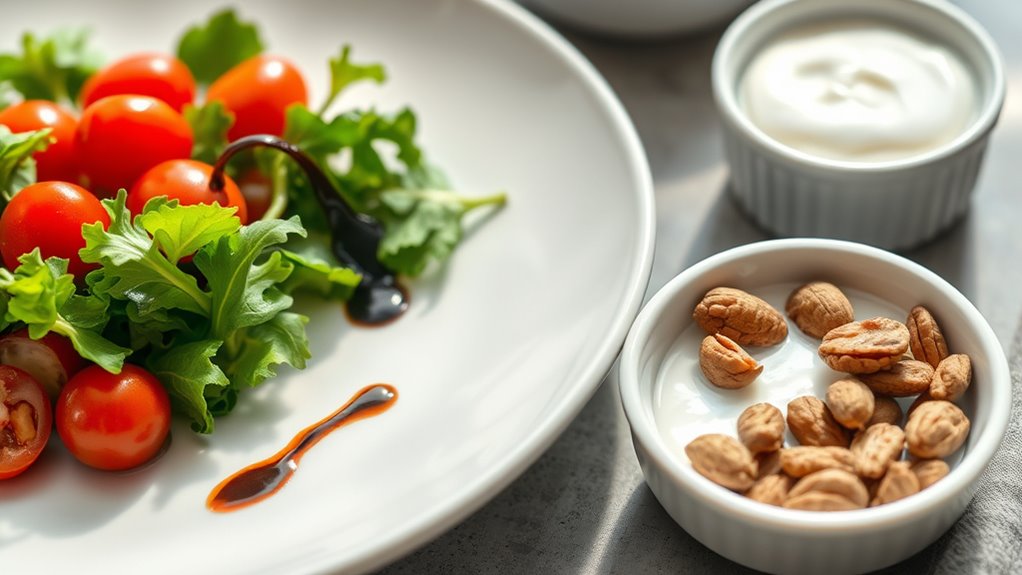To manage portion sizes with mindful eating, start by using smaller plates and bowls to create visual cues of appropriate servings. Slow down during meals, paying attention to your hunger and fullness signals. Focus on eating deliberately, savoring each bite, and checking in with your body to prevent overeating. These simple, intentional steps can help you enjoy your food more and maintain healthier portions—stay with us to learn more ways to master this balance.
Key Takeaways
- Use smaller plates and bowls to visually control portion sizes and promote satiety.
- Pause during meals to assess hunger and fullness, preventing overeating.
- Eat slowly and savor each bite to enhance awareness of natural fullness cues.
- Incorporate mindful routines that focus on food quality and moderation, reducing emotional eating.
- Develop consistent eating habits that balance enjoyment and portion control for sustainable health benefits.

Have you ever wondered how much food is enough without overdoing it? Managing portion sizes effectively starts with understanding plate control and listening to your hunger cues. When you focus on plate control, you’re intentionally shaping what goes onto your plate, rather than mindlessly piling it high. Use smaller plates or bowls to help create a visual cue that your portions are appropriate. Filling a smaller dish can trick your brain into feeling satisfied with less food, which naturally encourages better portion management.
Using smaller dishes helps control portions and tricks your brain into feeling satisfied with less food.
Hunger cues are your body’s signals that tell you when you’re truly hungry and when you’ve had enough. Learning to recognize these cues is *essential* for avoiding overeating. Before you start eating, ask yourself if you’re genuinely hungry or just bored, stressed, or craving certain flavors. During your meal, pause periodically—put your utensils down and check if you’re still hungry or if you’re starting to feel full. This moment of reflection helps you stay attuned to your body’s needs rather than eating out of habit or emotional comfort.
Practicing mindful eating makes it easier to stay in tune with hunger cues. Instead of rushing through your meal, eat slowly and savor each bite. This deliberate pace allows your brain to register fullness signals more effectively, preventing you from consuming more than necessary. As you eat, pay attention to how your body feels—notice the *shift* from hunger to satisfaction. Recognizing those subtle cues can be the difference between feeling comfortably full and overstuffed.
Incorporating plate control and hunger cues into your routine isn’t about strict dieting; it’s about creating a balanced approach to eating. You don’t have to avoid your favorite foods; instead, enjoy them in moderation by serving smaller portions and eating mindfully. This strategy helps you develop a healthier relationship with food, reducing guilt and promoting lasting habits. Additionally, understanding best airless paint sprayers can encourage you to approach your health goals with the same level of care and precision—focusing on quality and proper technique over speed or quantity. Over time, these small adjustments can lead to improved portion management, better digestion, and increased energy levels.
Frequently Asked Questions
How Can I Recognize True Hunger Versus Emotional Cravings?
To recognize true hunger versus emotional cravings, pay attention to your hunger cues and emotional triggers. True hunger develops gradually and feels like a physical need for food, whereas emotional cravings often come suddenly and are linked to feelings like stress or boredom. Ask yourself if you’re genuinely hungry or just seeking comfort. By tuning into your body’s hunger cues, you can better distinguish between physical hunger and emotional triggers.
What Are Quick Tips for Controlling Portion Sizes When Dining Out?
You might think controlling portions at a restaurant feels awkward, but it’s easy with some tips. Follow restaurant etiquette by politely asking for a half portion or sharing dishes. Use portion control tools like small plates or take leftovers home. Prioritize eating slowly and paying attention to your hunger cues. These simple strategies help you enjoy your meal without overeating, making dining out healthier and more enjoyable.
How Do Portion Sizes Vary Across Different Cultures?
Portion sizes vary widely across cultures due to cultural influences and traditional serving sizes. In some countries, meals are smaller and emphasize shared dishes, while others serve larger individual portions. You might notice that Asian cuisines tend to have modest servings, whereas American dishes often come oversized. Understanding these differences helps you make mindful choices, respecting cultural norms without overeating, and adapting your eating habits to suit different culinary traditions.
Can Mindful Eating Help With Long-Term Weight Management?
Yes, mindful eating can definitely help with long-term weight management. By paying close attention to hunger cues and eating slowly, you prevent overeating and develop healthier habits. Practicing mindful eating encourages you to choose appropriate portion sizes and savor your food, making it easier to maintain a healthy weight over time. Ultimately, this increased awareness supports sustainable weight maintenance and fosters a positive relationship with food.
What Are Common Mistakes to Avoid When Practicing Mindful Eating?
Think of mindful eating as steering a boat; distractions like distracted eating or mindful snacking can throw you off course. Avoid eating on the go or while distracted by screens, as they make you less aware of your fullness. Don’t rush your bites or ignore hunger cues. Stay present, savor each bite, and focus on your food, so you don’t overeat or miss the signals your body sends.
Conclusion
By practicing mindful eating, you become the captain steering your ship through a sea of temptations, guiding portions with steady hands and clear intention. Each mindful bite anchors you in the present, transforming eating from a rush to a deliberate dance. As you tune into your body’s signals, portion sizes shrink or expand with harmony, creating a balanced rhythm. Embrace this mindful approach, and watch your relationship with food blossom into a symphony of satisfaction and well-being.









